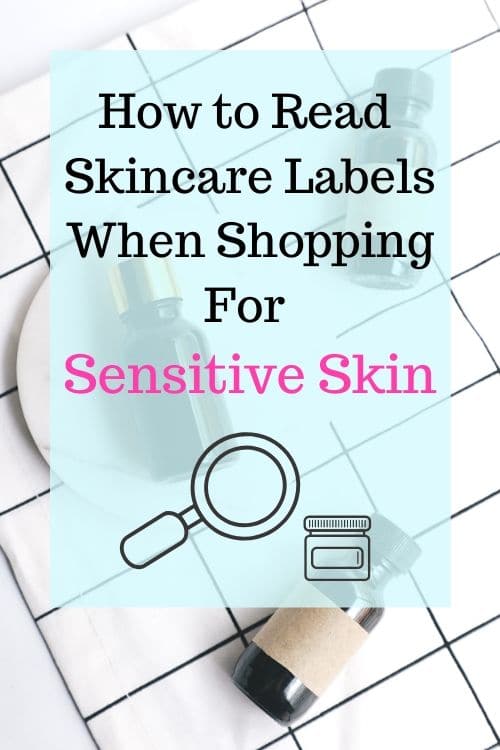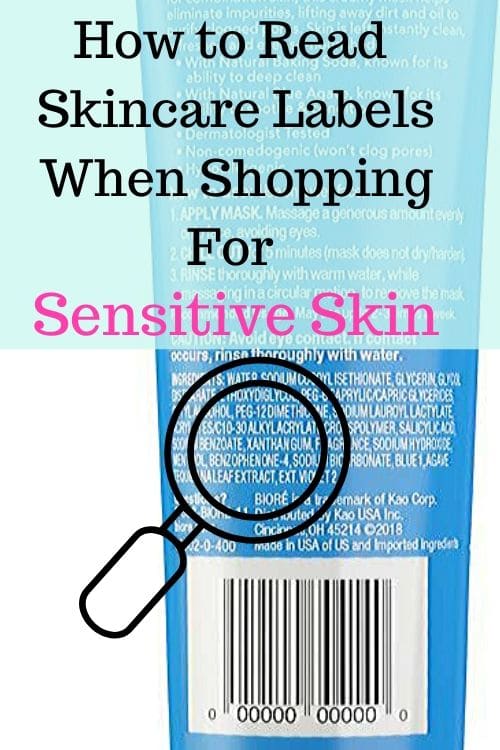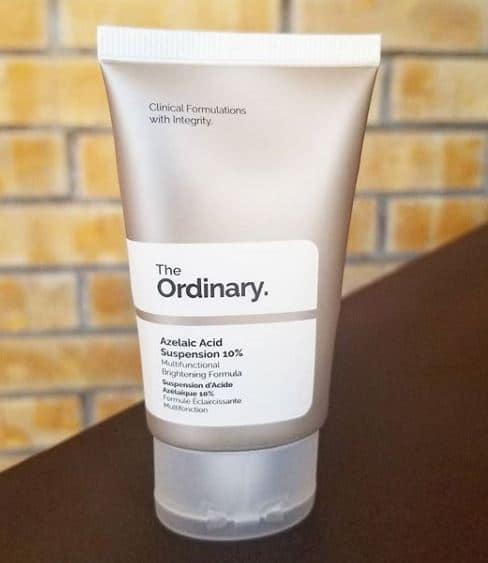The ingredient list on the back label of a skincare product might look like ancient Greek to the uneducated eye when you first try to decipher your product, but we’re going to change that! I’m going to break it down so you can easily read any skincare label while shopping for sensitive skin. It’s important to familiarize yourself with the ins and outs of the layout of a product label no matter what kind of skin type you are. But it’s an even more essential skill when you have sensitive skin!

This post contains affiliate links. If something is purchased through my link it will send some spare change my way that will go towards keeping this slice of the internet up and running.
How to Read a Skincare Label for Sensitive Skin
Here are the main things to look for when checking labels on skincare for sensitive skin:
- Are there any irritating ingredients?
- Does the cost of the product match the quality/quantity of ingredients used?
- Does the formula match up with what the product claims to do?
Let’s start by diving into the specific ingredients that you should watch out for while shopping for sensitive skin-friendly skincare.
Common ingredients to avoid when shopping for sensitive skin:
- Fragrance
- Dye/Pigment
- Menthol/Menthoxypropanediol/Menthyl Lactate
- Linalool
- Aggressive Physical Scrubs – apricot pits, walnut shells, or pumice
- Fragrant Essential Oils – things like lavender, bergamot, sandalwood, etc
- Citrus Extracts – this includes lime, lemon, grapefruit, orange, etc
- Mint Extracts or Oils
- Sodium Lauryl Sulfate (SLS)
- Pore Clogging Oils – coconut oil, shea butter, olive oil
If I spot any of the ingredients above I will immediately ditch the product. I used to be more lenient with wash-off products like cleansers or masks but once I became strict with 100% of my skincare I saw a huge improvement in my skin texture and far fewer breakouts.
These common active ingredients can be too aggressive for sensitive skin when used in high concentrations:
- AHA or BHAs
- Glycolic Acid
- Retinol
You can build up your skin’s tolerance to these chemical exfoliants but they can often be too irritating for extremely sensitive skin. Here are some gentler alternatives:
- PHA a.k.a Polyhydroxy Acid instead of BHA/AHA – try The Inkey List Polyhydroxy Acid (PHA) Gentle Exfoliating Toner
- Bakuchiol instead of Retinol – Bakuchiol has been proven to give the exact same benefits as retinol without the irritating side effects! The Herbivore Bakuchiol Serum is a great choice or for a more budget-friendly option I recommend The Inkey List Bakuchiol Moisturizer.
- Lactic Acid instead of Glycolic Acid – Lactic Acid does not penetrate as deeply as Glycolic which makes it great for sensitive skin. The Ordinary Lactic Acid 5% + HA is a staple in my sensitive skin routine.
Here’s how ingredient lists are sorted:
Ingredients are listed in descending order from greatest amount to least amount concentration in the product. There’s one exception to this, ingredients with a concentration of less than 1% can be listed at any order at the bottom of the descending list. There is no indication required for where the ingredients under 1% start on a label. This can make determining the amount of a specific ingredient that you might be interested in almost impossible!
Almost all preservatives and fragrances are used in concentrations of 1% or less. So it’s safe to say that any ingredients listed below preservatives in the list are less than 1%. Some common preservatives to watch out for while combing a list can include:
- Propylene and butylene glycols
- Tocopherol acetate
- Disodium and tetrasodium EDTA
- Diazolidinyl and imidazolydyl urea
- Ascorbyl palmitate
- Benzoic acid
- Benzyl alcohol
- Phenoxyethanol
- Methylisothiazolinone

Don’t get ripped off by a buzzword!
Just because the buzzword ingredient highlighted on the front of the package is the very last ingredient doesn’t necessarily mean you’re getting ripped off. Some ingredients are very beneficial even when formulated in extremely small concentrations. For instance, many active ingredients like glycolic acid, bakuchiol, and vitamin c are highly effective in small doses and will likely be near the bottom of any ingredient list. Most of these ingredients would actually do harm to your skin if companies used higher concentrations than 1-10%.
But, on the other hand, you will frequently see an ingredient showcased on the label used in a puny and basically useless concentration. The first five ingredients or so are typically the bulk of the formula. Let’s take a look at the ingredient list of the Biore Blue Agave & Baking Soda Whipped Mask. You would think that agave would be a star ingredient since Biore states “With Natural Blue Agave, known for its ability to soothe and condition”?
WATER, SODIUM, COCOYL ISETHIONATE, GLYCERIN, GLYCOL DISTEARATE, ETHOXYDIGLYCOL, PEG-6 CAPRYLIC/CAPRIC GLYCERIDES, CETYL ALCOHOL, PEG-12 DIMETHICONE, SODIUM LAUROYL LACTYLATE, ACRYLATES/C10-30 ALKYL ACRYLATE CROSSPOLYMER, SALICYLIC ACID, SODIUM BENZOATE, XANTHAN GUM, FRAGRANCE, SODIUM HYDROXIDE, MENTHOL, BENZOPHENONE-4, SODIUM BICARBONATE, BLUE 1, AGAVE TEQUILANA LEAF EXTRACT, EXT. VOILET 2.
As you can see above, it’s the second to last ingredient. Now I’m not saying that agave is only effective in high concentrations, this is just to highlight my point. Countless brands manufacturer products using trendy ingredients but actually only include a scant amount of the material in the formula.
How can you find the active ingredient percentages in skincare?
Some brands are awesome and clearly list the exact percentages of the active ingredient (or any other star ingredient) on the box or inside the product description online. The Inkey List and The Ordinary are great about making this information easily available as you can see on the treatment below.

If you’re comparison shopping for a specific product it’s helpful to know the concentration of the ingredient you’re going after so you can determine if the price is actually worth it. I went on a long journey trying to find the most cost-effective and high concentration of bakuchiol a few months back.
If the percentages are not disclosed on the packaging or the brand’s website you can reach out to the brand directly via social media DM or email. Some brands are happy to help and will gladly extend additional info about their formula. I have also run into brands that respond with something along the lines of “We don’t have to tell you” (I’m looking at you Biossance ?).
I personally think it’s a little shady for a company to refuse to disclose their concentrations when you’re paying +50$ for their product…..
How to decipher the ingredient names on a skincare label
Per INCI (the internationally accepted system for naming ingredients) guidelines, all ingredients must be named using their scientific and, for plants, Latin names. The English name for plant-derived ingredients is usually put next to the Latin in parenthesis.
For example, here’s a snippet from the Dr Jart Cream ingredient list: “Lavandula Angustifolia (Lavender) Oil, Disodium EDTA, Silica, Coccinia Indica Fruit Extract, Citrus Aurantium Bergamia (Bergamot) Fruit Oil”
Keep in mind that not every company will put the English name next to the Latin name. It’s super easy to quickly check an unknown ingredient using one of the countless cosmetic databases that are available online. Learn more about my two favorite resources below!
How to Check if Ingredients are Safe For Sensitive Skin
There are many websites that you can plug an ingredient list into to quickly check if the formula is sensitive skin friendly. My two favorite resources are CosDNA.com and the Paula’s Choice ingredient dictionary.
You can search CosDNA’s database to find the ingredient list for any product. It also shows the function of each ingredient, it’s irritation risk and how comedogenic it is (how likely to clog your pores). These entries are user-generated and you may sometimes run into an older formulation so keep an eye on the date of the post because brands often reformulate their skincare products.
Paula’s Choice is an amazing resource for learning about the benefits and possible risks of a specific ingredient. They also list an overall rating of the ingredient based on whether it has any research backing up its effectiveness and any risks it may have.
Once you’ve gotten the hang of skimming ingredient lists you’ll be able to quickly determine if a formula has any problem child ingredients. But in the meantime, while you’re still familiarizing yourself with the sometimes unpronounceable chemicals of the skincare world I highly recommend using these websites to learn about each ingredient.
